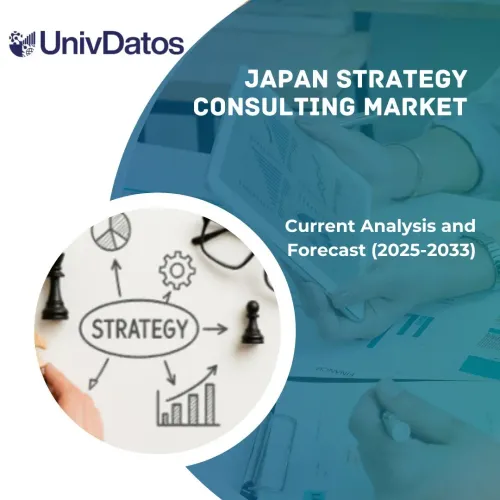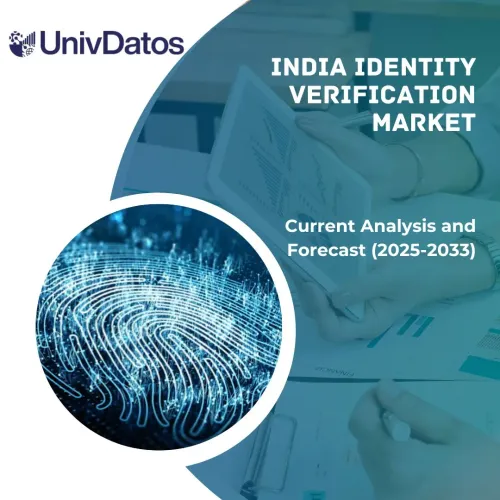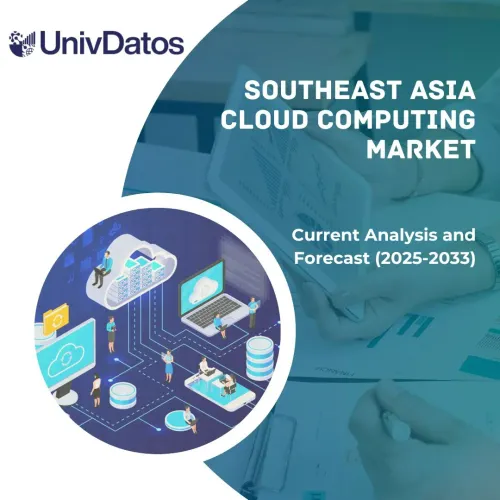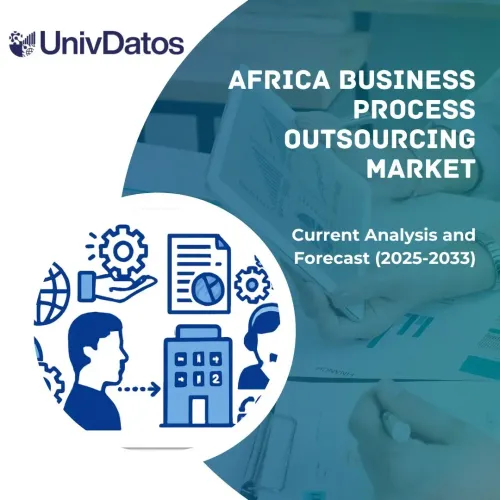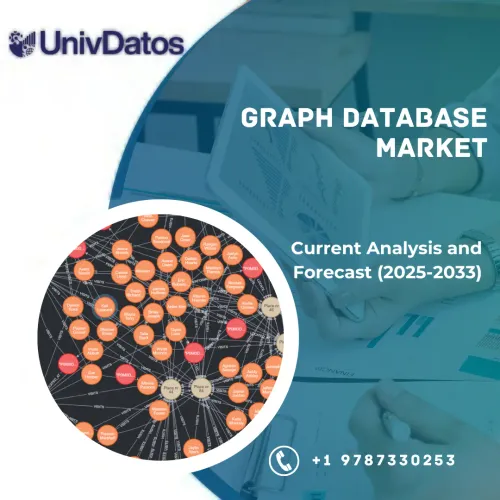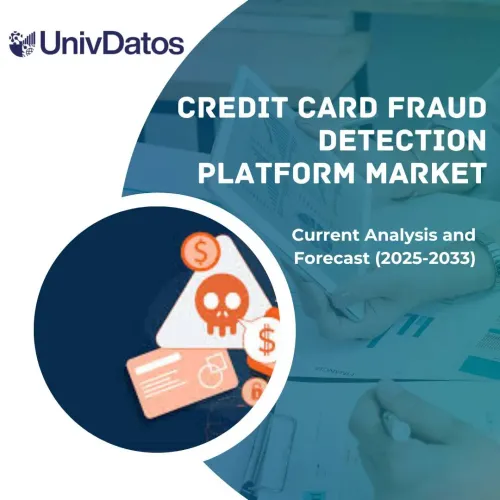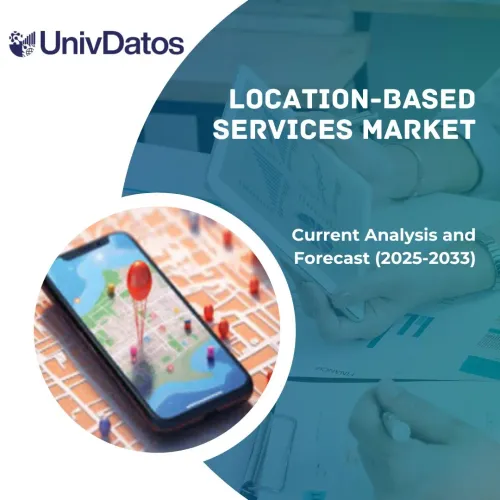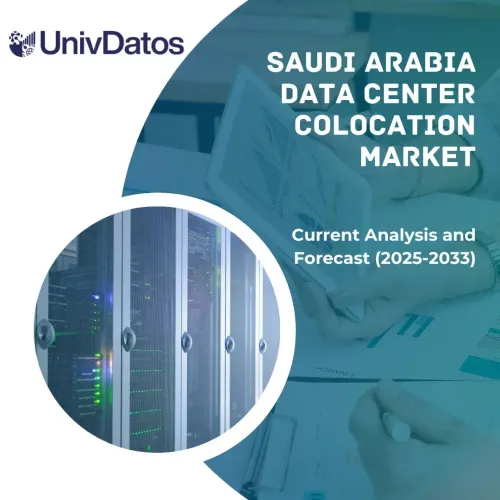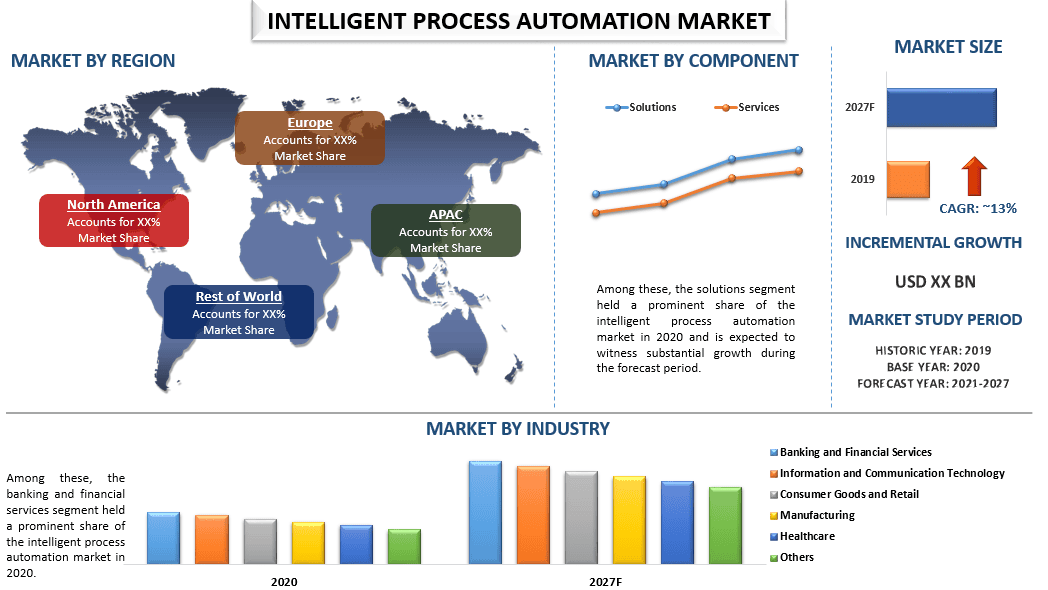
전 세계 지능형 프로세스 자동화 시장은 2021~2027년 기간 동안 약 13%의 연평균 복합 성장률(CAGR)을 기록할 것으로 예상됩니다. 전 세계 지능형 프로세스 자동화 시장은 기존 운영 방식을 수정하기 위한 자동화된 프로세스에 대한 수요 증가와 조직 전반에 걸쳐 신속한 의사 결정에 대한 요구 사항 증가로 인해 고양되고 있습니다. 또한, 비즈니스 프로세스의 품질과 효율성을 유지하면서 운영 비용을 절감하려는 요구가 증가하고 로봇 프로세스 자동화(RPA) 도입이 증가함에 따라 업계 환경이 긍정적으로 자극될 것입니다. 지능형 프로세스 자동화는 로봇 프로세스 자동화에 컴퓨터 비전, 인지 자동화, 머신 러닝과 같은 인공 지능 및 관련 신기술을 적용하는 것을 의미합니다. 또한 AI, 머신 러닝 및 RPA 기술의 발전은 지능형 프로세스 자동화 시장을 더욱 촉진하고 있습니다.
International Business Machines Corporation, Atos SE, Capgemini SE, HCL Technologies Limited, Blue Prism Limited, Accenture Plc, Cognizant Technology Solutions, Tech Mahindra Limited, Hyper Labs Inc. 및 Pegasystems Inc.는 시장의 주요 기업 중 일부입니다. 이러한 기업들은 하이테크 및 혁신적인 제품/기술로 고객을 지원하기 위해 여러 M&A와 파트너십을 수행해 왔습니다.
보고서에 제시된 통찰력
“기술 중에서 가상 에이전트 부문은 예측 기간 동안 상당한 성장을 보일 가능성이 높습니다.”
기술을 기준으로 시장은 머신 러닝, 자연어 처리, 신경망, 가상 에이전트 등으로 분류됩니다. 가상 에이전트 부문은 다양한 산업에서 가상 에이전트에 대한 투자가 증가함에 따라 금융 기관에서 가상 에이전트 구현이 증가함에 따라 예측 기간 동안 전 세계 지능형 프로세스 자동화의 주요 주주가 될 것으로 예상됩니다. 지능형 가상 비서의 한 가지 이점은 대화 전체에서 정보를 추적하고 진행하면서 학습할 수 있다는 것입니다.
“산업 중에서 은행 및 금융 서비스 산업은 2020년에 시장에서 중요한 점유율을 차지했습니다.”
산업을 기준으로 시장은 은행 및 금융 서비스, 정보 통신 기술, 소비재 및 소매, 제조, 의료 등으로 분류됩니다. 이러한 범주 중에서 은행 및 금융 서비스는 2020년에 전 세계 지능형 프로세스 자동화 시장에서 상당한 점유율을 차지했으며 예측 기간 동안 견고한 성장률을 보일 것으로 예상됩니다. 이 부문의 성장은 속도와 효율성 향상을 가능하게 하는 데이터 입력, 규정 준수 및 조립 및 제형과 같은 반복적인 작업의 자동화에 기인할 수 있습니다.
“APAC은 예측 기간 동안 상당한 성장을 보일 것입니다.”
APAC은 전 세계 지능형 프로세스 자동화 시장에서 상당한 점유율을 차지했으며 예측 기간 동안 꾸준한 성장률로 성장할 것으로 예상됩니다. 이는 대기업, 중소기업 및 소기업의 수가 증가하고 기업이 비즈니스 운영을 최적화하기 위해 지출을 늘리는 데 기인할 수 있습니다. 또한 정부의 지능형 프로세스 자동화 도입은 이 지역에서 이 시장의 성장을 더욱 촉진하고 있습니다. 또한 성장하는 은행 및 금융 서비스 산업은 이 지역의 지능형 프로세스 자동화 시장에 기여하는 또 다른 요인입니다. 예를 들어, 인도 브랜드 형평성 재단(IBEF)에 따르면 인도의 핀테크 시장은 2025년까지 834억 8천만 달러에 이를 것으로 예상됩니다.
이 보고서를 구매해야 하는 이유:
- 이 연구에는 인증된 주요 업계 전문가가 검증한 시장 규모 측정 및 예측 분석이 포함되어 있습니다.
- 이 보고서는 전체 산업 성과에 대한 빠른 검토를 한눈에 제공합니다.
- 이 보고서는 주요 비즈니스 재무, 제품 포트폴리오, 확장 전략 및 최근 개발에 중점을 두고 주요 업계 동료에 대한 심층 분석을 다룹니다.
- 업계에 널리 퍼져 있는 동인, 제약, 주요 추세 및 기회에 대한 자세한 조사.
- 이 연구는 다양한 부문에 걸쳐 시장을 포괄적으로 다룹니다.
- 업계에 대한 심층적인 지역 수준 분석.
맞춤화 옵션:
전 세계 지능형 프로세스 자동화 시장은 요구 사항 또는 기타 시장 부문에 따라 추가로 맞춤화할 수 있습니다. 이 외에도 UMI는 귀하의 비즈니스 요구 사항이 있을 수 있음을 이해하므로 귀하의 요구 사항에 완벽하게 맞는 보고서를 얻기 위해 언제든지 저희에게 연락하십시오.
목차
지능형 프로세스 자동화 시장 분석(2021-2027)을 위한 연구 방법론
글로벌 지능형 프로세스 자동화 시장의 과거 시장 분석, 현재 시장 추정, 미래 시장 예측은 전 세계 주요 지역에서 지능형 프로세스 자동화의 채택을 분석하고 생성하기 위해 수행된 세 가지 주요 단계였습니다. 과거 시장 수치를 수집하고 현재 시장 규모를 추정하기 위해 철저한 2차 조사가 수행되었습니다. 둘째, 이러한 통찰력을 검증하기 위해 수많은 결과와 가정을 고려했습니다. 또한 글로벌 지능형 프로세스 자동화 시장의 가치 사슬 전반에 걸쳐 업계 전문가와 함께 광범위한 1차 인터뷰도 수행되었습니다. 1차 인터뷰를 통해 시장 수치를 가정하고 검증한 후, 전체 시장 규모를 예측하기 위해 하향식/상향식 접근 방식을 사용했습니다. 그 후, 시장 세분화 및 데이터 삼각 측량 방법이 채택되어 산업 관련 세그먼트 및 하위 세그먼트의 시장 규모를 추정하고 분석했습니다. 자세한 방법론은 아래에 설명되어 있습니다.
과거 시장 규모 분석
1단계: 2차 소스에 대한 심층 연구:
연례 보고서 및 재무제표, 실적 발표, 보도 자료 등과 같은 회사 내부 소스 및 저널, 뉴스 및 기사, 정부 간행물, 경쟁사 간행물, 부문 보고서, 타사 데이터베이스 및 기타 신뢰할 수있는 간행물을 포함한 외부 소스를 통해 지능형 프로세스 자동화 시장의 과거 시장 규모를 얻기 위해 자세한 2차 연구가 수행되었습니다.
2단계: 시장 세분화:
지능형 프로세스 자동화 시장의 과거 시장 규모를 확보한 후, 주요 지역의 다양한 세그먼트 및 하위 세그먼트에 대한 과거 시장 통찰력과 점유율을 수집하기 위해 자세한 2차 분석을 수행했습니다. 보고서에 포함된 주요 세그먼트는 구성 요소, 기술, 배포, 조직 규모, 애플리케이션 및 산업입니다. 또한 해당 지역의 테스트 모델의 전체적인 채택을 평가하기 위해 국가 수준 분석을 수행했습니다.
3단계: 요인 분석:
다양한 세그먼트 및 하위 세그먼트의 과거 시장 규모를 확보한 후, 지능형 프로세스 자동화 시장의 현재 시장 규모를 추정하기 위해 자세한 요인 분석을 수행했습니다. 또한 지능형 프로세스 자동화의 다양한 구성 요소, 기술, 배포, 조직 규모, 애플리케이션 및 산업과 같은 종속 및 독립 변수를 사용하여 요인 분석을 수행했습니다. 전 세계 지능형 프로세스 자동화 시장 부문에서 최고의 파트너십, 합병 및 인수, 사업 확장 및 제품 출시를 고려하여 수요 및 공급측 시나리오에 대한 철저한 분석이 수행되었습니다.
현재 시장 규모 추정 및 예측
현재 시장 규모 산정: 위의 3단계의 실행 가능한 통찰력을 바탕으로 현재 시장 규모, 글로벌 지능형 프로세스 자동화 시장의 주요 업체 및 세그먼트의 시장 점유율에 도달했습니다. 필요한 모든 백분율 점유율 분할 및 시장 분석은 위에 언급된 2차 접근 방식을 사용하여 결정되었으며 1차 인터뷰를 통해 검증되었습니다.
추정 및 예측: 시장 추정 및 예측을 위해 이해 관계자에게 제공되는 동인 및 추세, 제약 및 기회를 포함한 다양한 요인에 가중치가 할당되었습니다. 이러한 요인을 분석한 후, 주요 시장 전반에 걸쳐 다양한 세그먼트 및 하위 세그먼트에 대한 2027년 시장 예측에 도달하기 위해 관련 예측 기술(즉, 하향식/상향식 접근 방식)을 적용했습니다. 시장 규모를 추정하기 위해 채택된 연구 방법론은 다음과 같습니다.
- 수익(USD) 측면에서 산업의 시장 규모와 국내 주요 시장에서 지능형 프로세스 자동화 시장의 채택률
- 시장 세그먼트 및 하위 세그먼트의 모든 백분율 점유율, 분할 및 분석
- 제공되는 솔루션 측면에서 글로벌 지능형 프로세스 자동화 시장의 주요 업체. 또한 빠르게 성장하는 시장에서 경쟁하기 위해 이러한 업체가 채택한 성장 전략
시장 규모 및 점유율 검증
1차 연구: 주요 지역에서 최고 경영진(CXO/VP, 영업 책임자, 마케팅 책임자, 운영 책임자 및 지역 책임자, 국가 책임자 등)을 포함한 KOL(Key Opinion Leader)과 심층 인터뷰를 수행했습니다. 그런 다음 1차 연구 결과를 요약하고 명시된 가설을 입증하기 위해 통계 분석을 수행했습니다. 1차 연구의 입력은 2차 결과와 통합되어 정보를 실행 가능한 통찰력으로 전환했습니다.
다양한 지역의 1차 참가자 분할
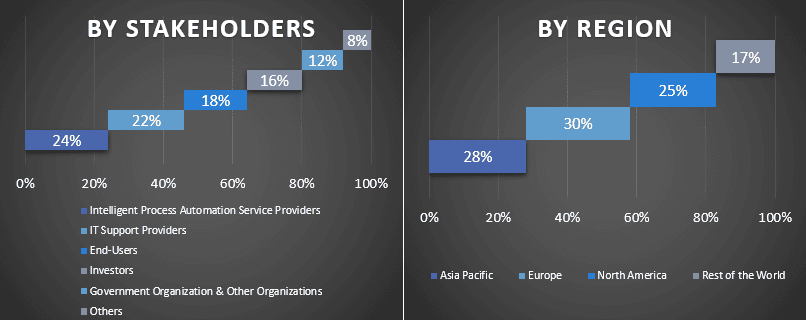
시장 엔지니어링
전체 시장 추정을 완료하고 글로벌 지능형 프로세스 자동화 시장의 각 세그먼트 및 하위 세그먼트에 대한 정확한 통계 수치를 도출하기 위해 데이터 삼각 측량 기술이 사용되었습니다. 데이터는 글로벌 지능형 프로세스 자동화 시장에서 구성 요소, 기술, 배포, 조직 규모, 애플리케이션 및 산업 분야의 다양한 매개변수와 추세를 연구한 후 여러 세그먼트 및 하위 세그먼트로 분할되었습니다.
글로벌 지능형 프로세스 자동화 시장 조사의 주요 목표
글로벌 지능형 프로세스 자동화 시장의 현재 및 미래 시장 동향이 연구에서 정확히 지적되었습니다. 투자자는 연구에서 수행된 질적 및 양적 분석에서 투자를 위한 재량을 근거로 할 수 있는 전략적 통찰력을 얻을 수 있습니다. 현재 및 미래 시장 동향은 지역 수준에서 시장의 전체적인 매력을 결정하여 산업 참가자가 미개척 시장을 활용하여 선점자 이점을 얻을 수있는 플랫폼을 제공했습니다. 연구의 다른 양적 목표는 다음과 같습니다.
- 가치(USD) 측면에서 지능형 프로세스 자동화 시장의 현재 및 예측 시장 규모를 분석합니다. 또한 다양한 세그먼트 및 하위 세그먼트의 현재 및 예측 시장 규모를 분석합니다.
- 연구의 세그먼트에는 구성 요소, 기술, 배포, 조직 규모, 애플리케이션 및 산업 분야가 포함됩니다.
- 지능형 프로세스 자동화 시장 산업에 대한 규제 프레임워크 정의 및 분석
- 다양한 중개인의 존재와 관련된 가치 사슬을 분석하고 업계의 고객 및 경쟁업체 행동을 분석합니다.
- 주요 지역에 대한 지능형 프로세스 자동화 시장의 현재 및 예측 시장 규모를 분석합니다.
- 보고서에서 연구된 지역의 주요 국가에는 아시아 태평양, 유럽, 북미 및 기타 지역이 포함됩니다.
- 빠르게 성장하는 시장에서 지속하기 위해 시장 참가자가 채택한 지능형 프로세스 자동화 시장 및 성장 전략의 회사 프로필
- 산업에 대한 심층적인 지역 수준 분석
관련 보고서
이 상품을 구매한 고객님들도 함께 구매하신 상품



